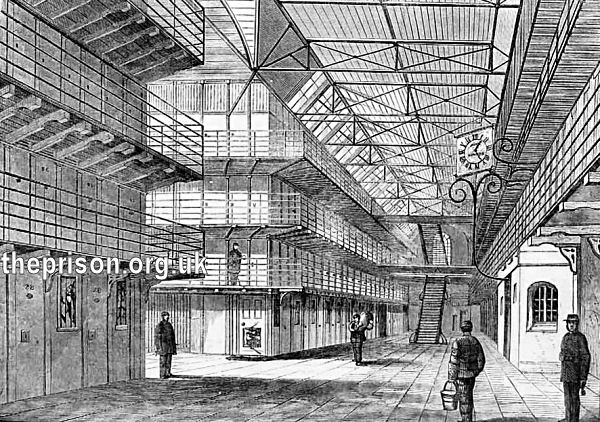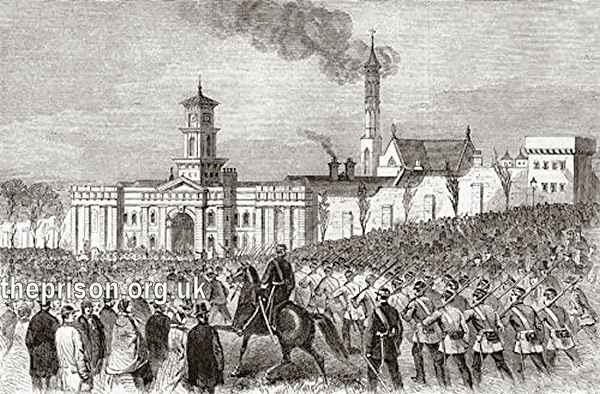St Mary's Prison, Chatham, Kent
In 1856, a new public works prison was opened on St Mary's Island, Chatham, adding to the existing two at Dartmoor and Portland. It initially received prisoners undertaking hard labour in the dockyard and royal arsenal at Woolwich, who had previously been housed on the hulks Defence and Warrior, which were being withdrawn from service.
The new buildings, designed by Joshua Jebb, were largely constructed from corrugated iron. The U-shaped entrance complex included an infirmary and punishment cells. At its rear, the chapel and office building was flanked by detached kitchen and workshop blocks. To their rear, the main building had a T-shaped layout. Its three four-storey wings, with internal galleries radiating from a central hall, provided a total of 1,135 cells. Each of its windows was shared by two cells. Outside the prison wall, was a row of six houses for officers and ten cottages, each housing four warders' families.

St Mary's Prison interior, Chatham, Kent, 1861.
An additional, brick-built wing was added in 1866, followed by a further wing for 250 inmates in 1869-70.
In 1861, the prison experienced a period of major unrest, after one of the prisoners managed to obtain a skeleton key. Although he was not able to make use of it, a minor riot occurred. The ringleaders were put in punishment cells and extra warders were called in but matters escalated, with the inmates smashing windows and breaking furniture. After a week of relative calm, fifty 50 inmates rushed a warder, robbed him of his keys and freed their fellow prisoners. The Governor’s office was burned to the ground. Despite there being 150 warders on site, they were unable to quell the situation and the army had to be called in, restoring order with heavy truncheons and muskets. A number of warders were dismissed for failing to prevent the riot.

Troops approaching St Mary's Prison, Chatham, Kent, 1861.
from 1876 to 1886, a small satellite branch of the prison operated at Chattenden Barracks.
In 1880, Chatham was selected to receive 'star class' convicts — first-time offenders — who were housed separately so as not be be corrupted by hardened criminals. In 1882, Chattenden took over the role of housing star class inmates.
The prison was closed in 1892 and the site was taken over by the Admiralty.
Records
Note: many repositories impose a closure period of up to 100 years for records identifying individuals. Before travelling a long distance, always check that the records you want to consult will be available.
- The National Archives, Kew, Richmond, Surrey, TW9 4DU. Holdings include: Register of prisoners (1856-92); Index to registers of prisoners (1863, 1881-92);
- The National Archives, Kew, Richmond, Surrey, TW9 4DU. Has a wide variety of crime and prison records going back to the 1770s, including calendars of prisoners, prison registers and criminal registers.
- Find My Past has digitized many of the National Archives' prison records, including prisoner-of-war records, plus a variety of local records including Manchester, York and Plymouth. More information.
- Prison-related records on
Ancestry UK
include Prison Commission Records, 1770-1951
, and local records from London, Swansea, Gloucesterhire and West Yorkshire. More information.
- The Genealogist also has a number of National Archives' prison records. More information.
Census
Bibliography
- Higginbotham, Peter The Prison Cookbook: A History of the English Prison and its Food (2010, The History Press)
- Brodie, A. Behind Bars - The Hidden Architecture of England's Prisons (2000, English Heritage)
- Brodie, A., Croom, J. & Davies, J.O. English Prisons: An Architectural History (2002, English Heritage)
- Harding, C., Hines, B., Ireland, R., Rawlings, P. Imprisonment in England and Wales (1985, Croom Helm)
- McConville, Sean A History of English Prison Administration: Volume I 1750-1877 (1981, Routledge & Kegan Paul)
- Morris, N. and Rothman, D.G. (eds.) The Oxfod History of the Prison (1997, OUP)
- Pugh R.B. Imprisonment in Medieval England (1968, CUP)
Links
- Prison Oracle - resources those involved in present-day UK prisons.
- GOV.UK - UK Government's information on sentencing, probation and support for families.
Except where indicated, this page () © Peter Higginbotham. Contents may not be reproduced without permission.



